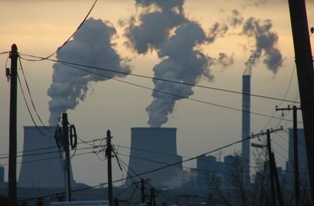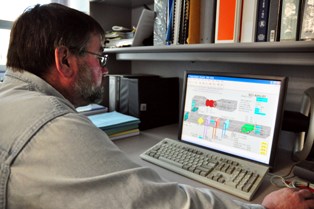We have much more to do and your continued support is needed now more than ever.
No Substitute for Efficient Buildings

It might be 5 am, but the cooks in one Winona University kitchen are already saving energy. In past years, the shift started with turning on the exhaust hood fan to prevent overheating, but now, thanks to a heat recovery system, a huge volume of warm air is being rerouted so the heat can be recycled for other purposes.
Like Winona, many colleges are harnessing and reusing heat that would otherwise go wasted in an attempt to minimize energy losses. With systems as diverse as waste heat boilers in power plants and heat recovery systems on kitchen hood fans, financial and environmental results are mixed.
Cutting heat energy waste in kitchens, locker rooms, and labs
Winona has put heat recovery systems to use in a variety of locales on campus. Most notable are the heat recovery coils that were installed to recapture heat as it leaves the laboratories when the new Science Laboratory Center was built in 2005.
Scott Kluver, power plant engineer chief at Winona, explains how the system works: “We’ve got 90 lab exhaust hoods throughout the building and six exhaust fans with heat recovery coils. All of the exhaust from the building lab hoods goes through these coils. So instead of blowing all of that 72 degree Fahrenheit (F) air outside, we recover that and put it back through the air handling unit as a preheat coil.”
This system takes the chilly winter air that’s, say, 30 degrees F and warms it up by 18 to 24 degrees F before it goes into the building. “The heat recovery system uses a glycol liquid solution that circulates throughout the system which then goes through the coils and the exhaust,” Kluver says. “The exhaust air warms up the liquid to be used as a pre-heat for the supply air system.”
This heat recovery system reduces the steam heat requirements for this $30 million, 112,000 ft2 building by 40 percent. Kluver estimates that this saves Winona approximately $64,500 annually in energy costs.
These same principles are being applied in the Memorial Hall locker room venting system, where the savings are estimated at around $11,500 every year. Once again, the warm exhaust air is used to pre-heat the outside air as it is brought into that area of the building. Kluver says, “This was installed in an existing building when we did an HVAC retrofit and locker room remodel in 2007 as an energy conservation measure.”
And of course, in the kitchens: “It used to be that when the cooks came in at 5 am they’d run the hood exhaust fans all day until they were done working at night,” Kluver comments. “So we put in a system that senses exhaust air temperature to adjust the variable frequency of the fans. Now it only uses electricity when needed, and instead of expelling 10,000 cubic feet per minute (cfm) of air all day long, it will often back down to 5,000 cfm. That means half as much air that we have to re-heat when it enters the building.” This solution was developed in-house as part of an energy-saving upgrade to the kitchen in 2008, with annual savings estimated at approximately $23,500.
Taking the waste out of on-site power generation
Other institutions, such as Rice University, are working the concept of heat recovery into their on-site power plants. Rice has two heat recovery boilers, alternatively called heat recover steam generators (HRSG) as well as cogeneration or combined heat and power (CHP) systems. These are downstream of two natural gas fired electrical generation turbines, one installed in 1985 (3.1 megawatt capacity), and the second in 1989 (3.8 megawatt capacity).
Douglas G. Wells, director of Rice University’s central plant, explains how these systems work: “HRSG systems use exhaust gases that might otherwise be wasted from a combustion source to produce steam. The exhaust gases are usually between 1000 and 2500 degrees F, and are most commonly produced by a turbine (a stationary jet engine) burning natural gas, diesel, or some other form of fuel.”
Making more complete use of a fuel stream is a precise science with these systems that capture two (or more) kinds of uses from the fuel. “In our case, we generate electrical energy from the initial burning of the fuel and then use the waste heat to produce steam for use on the Rice University campus,” says Wells. “This process extracts between 60% and 75% of the useful work out of the fuel, as opposed to using electricity from the power grid and burning gas separately for heating, a set of processes that maybe only use between 30% to 50% of the work available from a typical fuel source.”
“These systems were originally installed as a utility cost avoidance strategy, and not part of a greenhouse gas or emissions reduction plan,” says Wells, who estimates the net savings (after a 5- to 7-year payback of the initial investment) from the cogeneration systems to be between $1 and $2 million annually. “However, they have played a key role in helping the university minimize its overall environmental impact and reduce the university’s direct impact in regards to emissions. Conservative estimates for the amount of CO2 avoided because of these units range from 15,000 to 20,000 metric tons a year.” (To put that in perspective, that is about 20 times the emissions of the NWF headquarters building in Reston, VA.)

Economics a bigger determiner than green goals
According to the NWF’s 2008 Report Card, nine percent of schools report using some form of CHP produced by renewables or low-carbon fuels other than coal. University of Cincinnati (UC) is one of them, running a waste heat recovery system at their power facilities to re-capture wasted energy. UC’s steam generator produces 90 percent of the institution’s electricity needs, about half of which is generated through the waste heat boiler.
“Duke Energy electric prices are so high right now that it is cheaper for us to make our own power than buy from the utility,” explains Joe Harrell, executive director of utilities at UC. In the past, natural gas prices were so high that it didn’t make sense to produce their own power except during peak hours, but these days, they’re running the system 24/7.
“We track our CO2, but we’re not running this for CO2 reduction,” explains Harrell. “It is a utility plant, so we run it based on market economics. The fact that it’s cleaner is good, but it’s not the primary driver.”
UC currently purchases landfill gas to run their steam generator. As a result, the energy it produces is considered “renewable” by the state, which allows UC to sell renewable energy credits. Fuel costs and energy credit income are about equal, which means UC is just breaking even at this point. “In the future, as carbon legislation becomes law and coal-based electricity becomes expensive, then you’ll see a cleaner plant like this be more economically justifiable,” he says plainly.
The fact that economics plays such a major role in whether the plant runs is a concern for Harrell. “For every piece of electricity I produce, I emit about half the CO2 that the utility company does. But right now, that doesn’t get me any economic justification.”
In fact, there have been years when it wasn’t financially feasible to run the plant at all. One year in the recent past saw such high natural gas prices that the plant was shut down for the entire year, requiring the institution to lay off six staff members.
And, though the $80 million system cost about the same as a new boiler unit, Harrell feels that the money could have been better spent on improvements that would provide consistent, year-to-year CO2 and financial benefits. “I would invest every penny of that in the buildings to use less energy, because that’s where you’re going to get the biggest bang for your buck. Whether I buy the electricity or we produce it with the plant, there’s no sense in wasting it with inefficient buildings.”
Kluver also thinks that capturing waste heat is only one of a series of actions that need to be taken, and that the small improvements they’ve made at Winona in their buildings have been worth every penny. Though staff members have had to take some specialized training to adapt to the new systems, now that the bugs have been worked out of each, they require minimal additional maintenance. And with an ROI between 8 and 12 years for the kitchen exhaust hood sensing system, these heat recovery systems seem to make for good investments. He says, “I would do it again.”





















